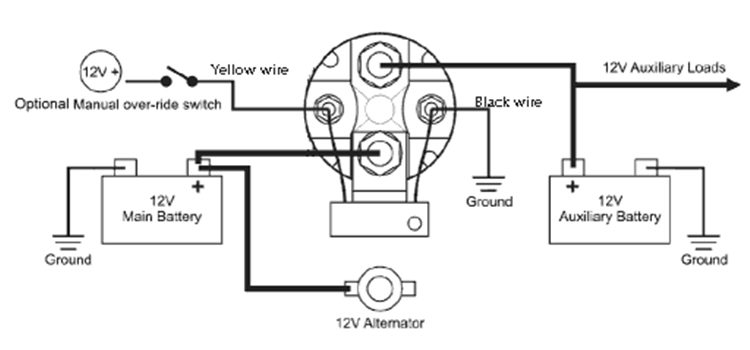4 Pole Solenoid Wiring Diagram | How It Works?
You will find one of the bigger terminals is attached to the hot wire coming from the battery, the second large terminal is connected to the starter, the first shorter terminal (S) connects to the ignition switch, and the second small terminal is normally unused in a 4 pole solenoid wiring. Make certain that the frame is grounded.
A solenoid switch is an electrical switch that is commonly used when a low current switch activates a high current circuit, such as a starting motor circuit. The circuit between the battery and the solenoid switch is complete when the key switch is flipped to Start and the gearshift is in neutral.

Wiring Diagram of 4 Pole Solenoid
A starting solenoid typically has four terminals: two for the high current circuit and the other two for the low current terminals, which are connected to the inner coil and activate the high current device on the high power end. The connectors are 2 tiny solenoid switch connections. And for the high current switch, two thicker and larger connections are required.
Assuming you’re doing this wiring in a car, you’ll most likely be using a 12V battery. It is recommended that you use black wire for negative and red wire for positive. You may use brown or orange wires on the high-current end of the circuit to differentiate them from the solenoid to battery connections if you wish.

How to Wire a Solenoid Switch [4-Pole Starter] – Drive and Cruise
How a 4 Pole Solenoid Work?
A solenoid can include a coil winding such as copper to produce a magnetic field with an electrical current. Rather than sending all the current through a switch such as an ignition switch, the assembly uses that switch by working as a relay. The solenoid inside the assembly creates a magnetic field that will pull a momentary switch to close the circuit.
When the switch is open, the solenoid will lose its magnetism and the momentary switch will open as well. The pole terminal is an optional pole that is meant to provide current to some ignition coils or ballast resistors depending on the ignition setup.
What are the Applications of Solenoid?
Solenoids provide the safe and simple activation and deactivation of any type of electrical ON and OFF component. They enable the activation and management of high current circuits by switching on two contacts that require far less power to activate than the current that the solenoid would handle.
When a moderate amount of current is delivered to a solenoid, a coil within creates a magnetic field that causes a plunger to move, causing the high current switch to close.
Testing of 4 Pole Solenoids After Wiring
Make every effort to hear “click” sounds. If the click is powerful and loud, it indicates that the solenoid has sufficient power and is functioning correctly. If you hear a quiet or persistent clicking, it is possible that your solenoid is not powerful enough or does not receive enough current from the battery.
If you hear no sound or the car won’t start, it might be due to a defective solenoid. When you switch on the ignition, you should notice a reduction in voltage as well. A voltage drop of roughly 0.5V is the target range. If you see a considerable increase or decrease, it’s time to replace your solenoid.
3-Pole Solenoid to 4-Pole Solenoid Replacement
Disconnect the OEM car battery’s positive (+) and negative (-) cables. Disconnect the 3-post solenoid’s power, trigger, and load wires. Unbolt the 3-post solenoid from its mounting place and disconnect the ground wires from the mounting bolt when finished. Replace the present ground wires’ ring terminal connection with a new ring terminal size for a #10 pole.
Install the new 4-post solenoid in the same place as the old 3-post solenoid. replace the ground wires on the mounting bolts but do not reinstall them. A dedicated ground post is included with the new solenoid. Reconnect the existing wires for power, trigger, load, and ground. Reconnect the OEM car battery’s positive and negative wires.
Frequently Asked Questions
Does it matter which wire goes where on a solenoid?
You’re clear to go if the wires are linked to a terminal. The tiny gauge wires on the little terminal are the same as those on the bigger terminal. It makes no difference because it isn’t stated in the instruction manual.
Conclusion
The color of the 4 pole solenoid wires will vary depending on whether you are using the solenoid to turn on and off the negative or positive cable of the device.
Subscribe to our newsletter
& plug into
the world of circuits